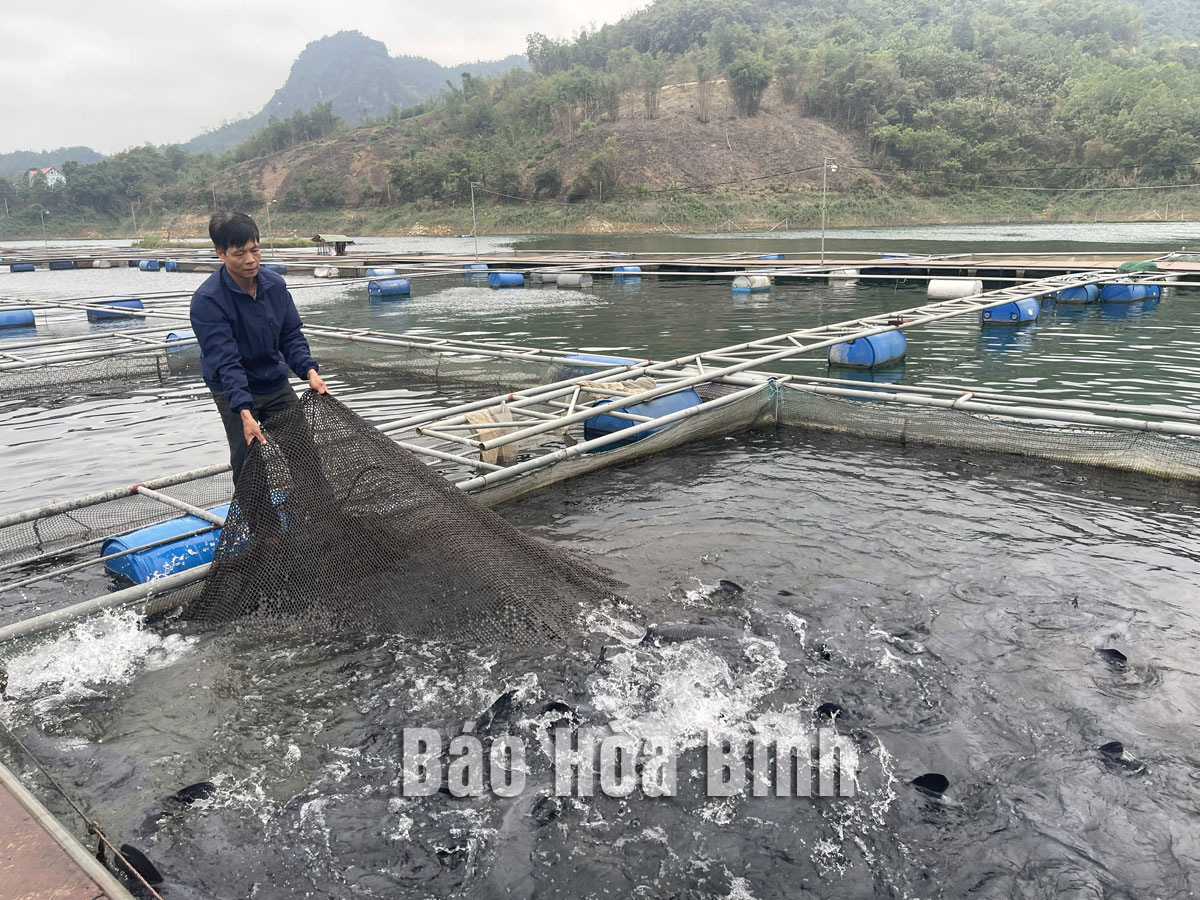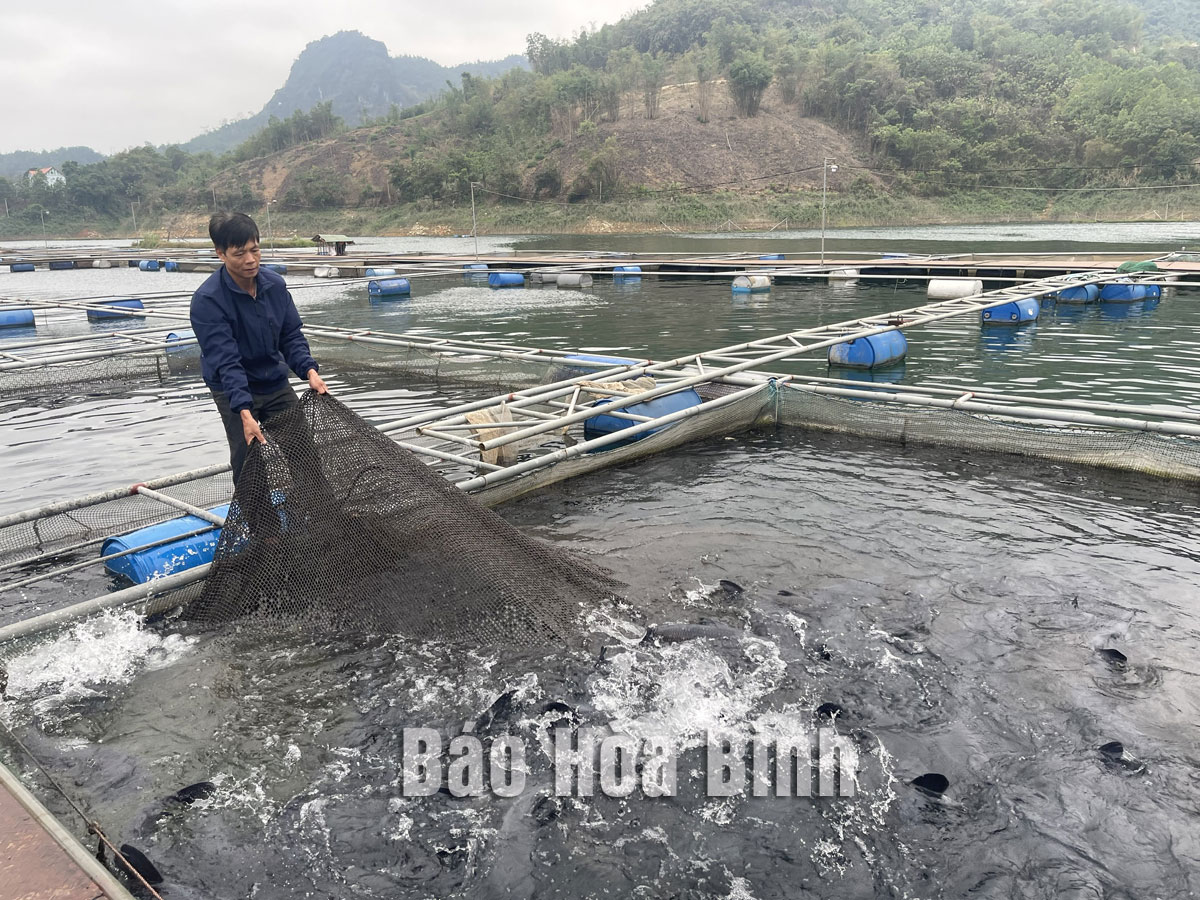
(HBO) – Hoa Binh province currently has 2,695 hectares of water surface and 4,900 fish farming cages. The fish output was estimated at 3,065 tonnes in the first quarter of this year, including 2,577 tonnes of farmed fish.
In recent years, to exploit the potential, protect and develop
aquatic resources, the provincial Department of Agriculture and Rural
Development has directed agencies to accelerate the restructuring of the
fishery sector towards increasing the proportion of aquaculture production,
focusing on specialist species with high quality and value. It has also
promoted the application of farming technology, improved the caring process,
and diversified fish products.
Hung Nguyen
Aquaculture Company in Da Bac district’s Vay Nua commune has 150 fish cages,
supplying more than 200 tonnes of fish to the market each year.
Duong Duc Anh's family, who lives at Moi hamlet in Cao Phong district’s Thung
Nai commune, has engaged in fish farming for 8 years with 80 cages and a total
output of 40 tonnes of fish. However, now his family maintains 50 fish cages
with a production of about 20-25 tonnes a year to ensure their quality.
Pham The Tu from Hung Nguyen Aquaculture Company,which is located in Da
Bac district’s Vay Nua commune, said it has 150 fish cages with an annual
output of more than 200 tonnes.
The company mainly raises different types of catfish such as ca
lang vang (yellowhemibagrus),black carp, andred
tilapia(Oreochromis spp). In order to produce quality products, it has strictly
followed the production process that meets VietGAP standards. Accordingly, the
water source for fish farming is tested regularly to ensure hygiene. The fish
is bred until reaching maturity, assuring that its meat is firm and delicious
when it is supplied to the market.
In recent years, with a large water surface area, especially in the Da River
reservoir, aquaculture is considered one of the province's competitive
advantages. In 2022, with a total output of more than 12,000 tonnes and stable
selling prices, aquaculture contributes a high proportion to the growth of the
agricultural industry.
However, according to the Fishery Sub-Department, although positive changes
have been recorded in the aquaculture industry in recent years, its development
has not been commensurate with the potential of the province.
The introduction of fish varieties with high economic value and specialty
species into farming is still limited due to high input costs, and people still
have difficulty in securing investment for their production.
Obstacles relating to the allocation and leasing of water surface cause
difficulties for small-scale farmers in the registration of farming cages.
The linkage between farmers and businesses is still limited while there is no
plant for post-harvest fish processing and storage, leading to difficulties in
the selling of the products.
Hoang Van Son, Director of the Fishery Sub-Department, said with
great potential from the Da River reservoir, the volume of aquaculture
production in the lakebed area can reach 16,000 tonnes of fish a year.
In the coming time, the fishery sector will review and devise a master plan for
the sector towards safe, efficient and market-oriented production.
It will focus on promoting the strength of the water surface for aquaculture,
applying new technologies to fishery activities to diversify products
andincrease income for farmers.
The sub-department will enhance the prevention of diseases, develop aquaculture
towards diversifying species and farming methods, continue to maintain the area
of fish farming in ponds and small lakes as well as raise fish in fields and
reservoirs.
Awareness of organisations and individuals in the protection and regeneration
of aquatic resources will be enhanced./.
Since the beginning of this year, under the direction of the Department of Agriculture and Environment, the Sub-Department of Agricultural, Forestry, and Fishery Product Quality Management has strengthened the integration of the professional activities to promote and guide the organizations and individuals in the production and trading of agricultural, forestry, and fishery products to comply with the legal regulations regarding the use of chemicals, pesticides and veterinary medicines in crop cultivation, livestock farming and aquaculture. They also provide guidance to processing and manufacturing establishments on keeping the records to trace the product origins and using food additives from the approved list according to the regulations.
Hoa Binh province saw a significant rise in state budget revenue in the first two months of 2025, heard a meeting chaired by Vice Chairman of the provincial People’s Committee Quach Tat Liem.
Ha Thi Ha Chi, a 26-year-old graduate in law, has taken an unconventional path by returning to her hometown in Mai Chau district to establish the Tong Dau Cooperative, creating stable jobs for local women and bringing Thai ethnic brocade weaving to the global market.
As the Lunar New Year 2025 approached, pork prices surged, creating a profitable season for farmers in Tan Vinh commune, Luong Son district. Taking advantage of the rising demand, Can Minh Son, a farmer from Coi hamlet, sold over 30 pigs at 69,000 VND/kg, each weighing more than 100 kg. After deducting expenses, his family earned a profit of over 50 million VND.
alternate member of the Central Party Committee, Secretary of the Hoa Binh provincial Party Committee Nguyen Phi Long on March 5 had a working session with Yan Jiehe, Founder and Chairman of the China Pacific Construction Group, one of China's largest private corporations in the field of transport infrastructure. Deputy Secretary of the provincial Party Committee, Chairman of the provincial People's Committee Bui Duc Hinh and leaders of provincial departments and sectors also attended the working session.
The electronic printed circuit board (PCB) manufacturing and processing plant of Japan’s Meiko Group, located at Da River Left Bank Industrial Park in Hoa Binh city with a total investment of over 200 million USD, is expected to create thousands of jobs and make a significant contribution to the local budget.



